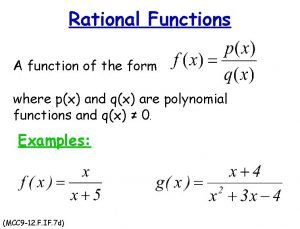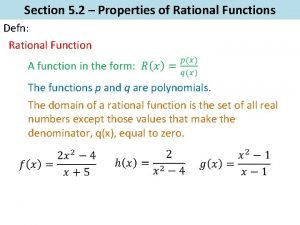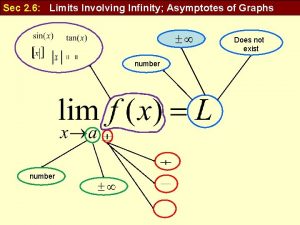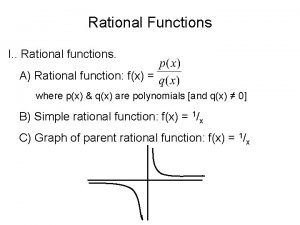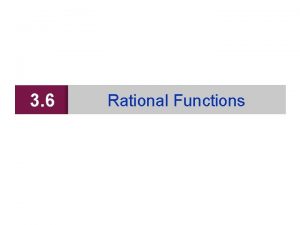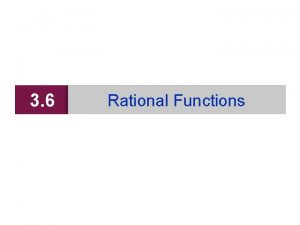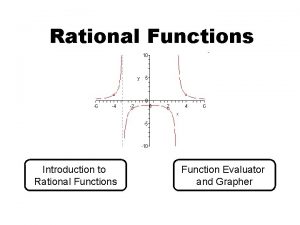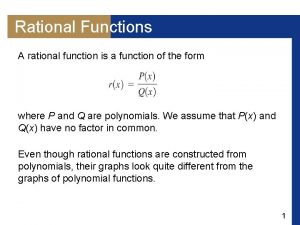RATIONAL FUNCTIONS A rational function is a function











- Slides: 11

RATIONAL FUNCTIONS A rational function is a function of the form: where p and q are polynomials

What would the domain of a rational function be? We’d need to make sure the denominator 0 Find the domain. If you can’t see it in your head, set the denominator = 0 and factor to find “illegal” values.

The graph of looks like this: If you choose x values close to 0, the graph gets close to the asymptote, but never touches it. Since x 0, the graph approaches 0 but never crosses or touches 0. A vertical line drawn at x = 0 is called a vertical asymptote. It is a sketching aid to figure out the graph of a rational function. There will be a vertical asymptote at x values that make the denominator = 0

Does the function have an x intercept? There is NOT a value that you can plug in for x that would make the function = 0. The graph approaches but never crosses the horizontal line y = 0. This is called a horizontal asymptote. A graph will NEVER cross a vertical asymptote because the x value is “illegal” (would make the denominator 0) A graph may cross a horizontal asymptote near the middle of the graph but will approach it when you move to the far right or left

VERTICAL ASYMPTOTES Finding Asymptotes There will be a vertical asymptote at any “illegal” x value, so anywhere that would make the denominator = 0 So there are vertical asymptotes at x = 4 and x = -1. Let’s set the bottom = 0 and factor and solve to find where the vertical asymptote(s) should be.

HORIZONTAL ASYMPTOTES We compare the degrees of the polynomial in the numerator and the polynomial in the denominator to tell us about horizontal asymptotes. 1<2 degree of top = 1 If the degree of the numerator is less than the degree of the 1 denominator, (remember the x axis isdegree a is the highest horizontal asymptote. power on. This any is x term) the along the xline axis y= is 0. a horizontal asymptote. degree of bottom = 2

HORIZONTAL ASYMPTOTES The leading coefficient is the number in front of the highest powered x term. degree of top = 2 If the degree of the numerator is equal to the degree of the denominator, then there is a horizontal asymptote at: y = leading coefficient of top leading coefficient of bottom 1 degree of bottom = 2 horizontal asymptote at:

OBLIQUE ASYMPTOTES degree of top = 3 If the degree of the numerator is greater than the degree of the denominator, then there is not a horizontal asymptote, but an oblique one. The equation is found by doing long division and the quotient is the equation of the oblique asymptote ignoring the remainder. degree of bottom = 2 Oblique asymptote at y = x + 5

SUMMARY OF HOW TO FIND ASYMPTOTES Vertical Asymptotes are the values that are NOT in the domain. To find them, set the denominator = 0 and solve. To determine horizontal or oblique asymptotes, compare the degrees of the numerator and denominator. 1. If the degree of the top < the bottom, horizontal asymptote along the x axis (y = 0) 2. If the degree of the top = bottom, horizontal asymptote at y = leading coefficient of top over leading coefficient of bottom 3. If the degree of the top > the bottom, oblique asymptote found by long division.

Graphing Rational functions • Find the y-intercept (if there is one 0 let x=0 • Find the x-intecepts (if there any) by solving the equation p(x)= 0 • Find any asymptotes • Plot a few additional points • Graph!!

Graph f(x)= 2 x-1
 Rational functions parent function
Rational functions parent function Rational parent function equation
Rational parent function equation Parent log function
Parent log function Rational fucntion
Rational fucntion Solving rational equations and inequalities
Solving rational equations and inequalities Rational robot ibm rational supports which os
Rational robot ibm rational supports which os How to find horizontal asymptotes
How to find horizontal asymptotes Unit 8 rational functions homework 1
Unit 8 rational functions homework 1 Rational expressions and functions
Rational expressions and functions Rational function
Rational function How to find a vertical asymptote
How to find a vertical asymptote What is rational function
What is rational function



